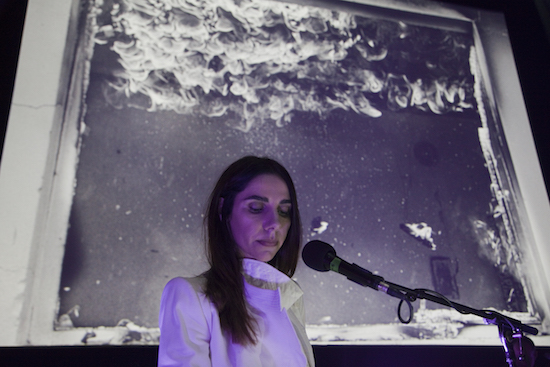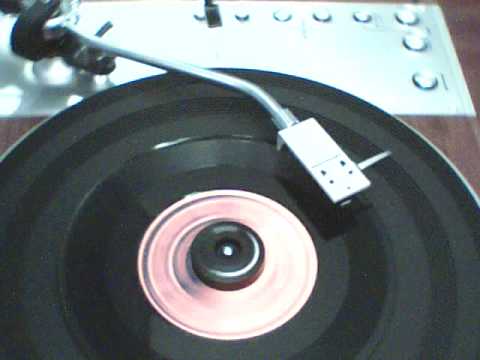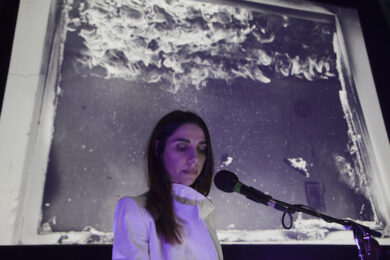In the second of Seamus Murphy’s three short films tonight, an old man stands hunched over on a busy street in Afghanistan, back turned to the camera with one hand outstretched. Passersby ignore or actively avoid his petitions as the traffic rolls by oblivious. Barely visible from our high vantage point is a small white square in his hand, “perhaps a religious icon” Murphy hypothesises in conversation with journalist and compére for the night, Anthony Loyd. “Great marketing,” he says “but it doesn’t work”. By contrast, a full house has turned out for this special evening as part of the London Literature Festival at Southbank Centre to launch PJ Harvey’s first book of poetry, The Hollow Of The Hand written in collaboration with Murphy whose images accompany the poems. Of course, the promise of some new songs probably didn’t hurt either.
Following their collaboration on Harvey’s last album Let England Shake (Murphy made a music video for each of the twelve songs on the album), Harvey and Murphy spent 2011 to 2014 visiting locations in Kosovo, Afghanistan and Washington, D.C. These were areas which Murphy had watched change during his extensive work as a press photographer, but which were completely new to Harvey. Murphy took photographs and footage for the short films that appear this evening, while Harvey gathered words and ideas for poems and the songs on her upcoming album.
Thematically, Hollow Of The Hand has much in common with Let England Shake, where Harvey asked difficult questions of national identity and how violence, both inflicted on and committed by a country, is an integral shaping force in that identity. But, here her lens has shifted from England and the military jingoism of empire to take in a more global view of the cycles of violence that have shaped sites of modern warfare and its individual human cost, and the locations reflect this: Kosovo is still in a state of unresolved independence and recovering from the cycles of retaliation and ethnic cleansing in the conflicts that followed the disintegration of Yugoslavia. Meanwhile, Afghanistan is in its thirty-sixth year of ongoing conflict having been contested and occupied by both local and global forces, and where the lines on the map continue to change. Comparatively, Washington D.C. is a site closer to home that has determined global military activity, but its cost at home is clear in the extensive imposing memorials to the war dead and with its eyes set outwards neglects struggling individuals (workers regularly hold down multiple jobs in order to meet their medical insurance costs) and communities like nearby Anacostia.
The evening is split between these locations, each comprising of a short film by Murphy followed by a discussion of his photographs with Loyd, before handing over to Harvey for poetry and music with longtime cohort John Parish and Gallon Drunk man James Johnston.
While Murphy’s films focus on details encountered during his travels with Harvey, his photographs range from the last twenty years during his previous visits to these locations and so we see them during different stages of conflict and recovery. Particularly in Kosovo, images range from towns like Mitrovicë segregated between Albanians and Serbians and burning homes as retaliations between ethnic groups heightened, to returning families picking over the remains of their former dwellings or being rehoused (one family in former quarters of Slobodan Milošević’s henchmen).
His images also have a remarkable range in tone against such backdrops of strife. The presence of violence moves from the abstractly distant like discarded personal effects at a Kosovo massacre site, to the uncomfortably close as we are confronted with the blasted husk of a torso after an airstrike (“Airstrikes have a purpose,” Murphy comments. “But, they’re easy and I wanted to show what they look like up close”). Others still are humorously absurd, as an abandoned Kosovo convenience store is overrun by browsing cattle, or ruby red shoes poke out beneath a woman’s blue burqa on a muddy street in Kabul, as if Dorothy had made a mistake on the return from Oz. “A prostitute,” Murphy reveals, “War does produce some amazing juxtapositions”. But most of all, in his anecdotes and images of people in all three countries singing, dancing, caring for animals, taking part in religious ceremonies and children playing, Murphy emphasises the resilience and continuation of life amidst immense turmoil.
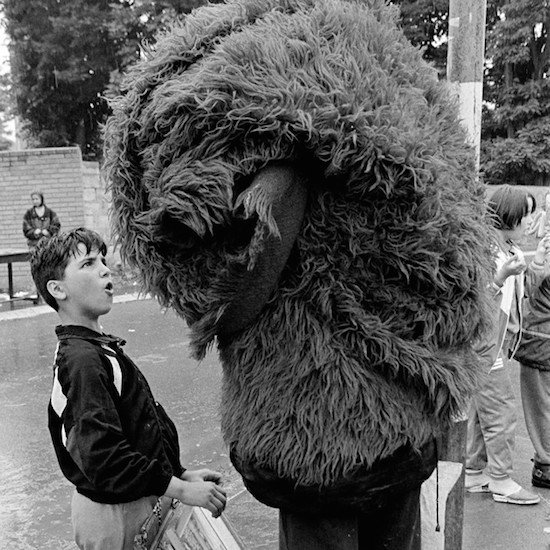
Similar to Murphy’s images, Harvey’s poems are snapshots capturing impressions and encounters from their travels and, admittedly, have their flaws and lack the confidence of her music. The clipped reportage style of some poems can lack focus and there are moments where her objectivity slips in the guilt of ‘The Guest Room’ (“I hope we know when to leave”) or ‘The Boy’, which comes perilously close to appropriation as a boy leads her through the dodgy terrain of Afghan slums (“Young boy in your face / every loss I can trace / Follow you enter in /Put my feet in your foot prints”). These moments are in the minority though, and on the whole her portrayal of places and individuals are sensitively done, objectively bearing witness to the effects of intense violence without resorting to distorting sentiments. She excels in focusing on the small details that effectively convey the human cost of conflict, like the hands of Zagorka, an elderly Kosovar woman who presides over her abandoned village in case the inhabitants return. Her hands bring the house keys ‘together and apart again’, until the visitors overstep their mark and ‘both keys move into a fist’. And as in her lyrics, she is astute at deconstructing the rhetoric that surrounds conflict, as in ‘Charikar’ where the line “It’s not a game. They’re out to win. / They have to get some practice in” sardonically echoes the language of pro-First World War poetry, as Harvey notes the latent hostility that runs under the domestic surface of an Afghan town: ‘There must be something in the air. / There is fighting everywhere”. And when she looks to an allegorical past for violence’s origin, asking the reconstructed skull of an early Homo sapiens in Washington D.C. or a stray dog in Afghanistan, she is confronted by the violence of the present (‘They die young around here / with hungry bellies and a taste for vodka”) or the likelihood of our extinction: “I will be here still / long after you have gone”. As with Murphy’s images, Harvey’s poetry is full of empathic insight and the central focus is on the “common humanity” that Loyd emphasised in his introduction to the evening, that exists amidst conflict and post-conflict.
Unsurprisingly, Harvey moves fluidly between poetry and music, as an organ or shuffling beat impinges on the closing words of a poem and she walks over to take position behind a mellotron or guitar. These songs which were last witnessed in their putative form in the basement of Somerset house back in January are now confident and fully-formed. ‘Chain of Keys’ lurches on a grinding blues groove close to To Bring You My Love territory while ‘The Orange Monkey’s organ driven search through time and space for violence’s first cause is closer to the mood pieces of Is This Desire? It is here that Harvey is in her element. Where her poetry reading may have shown a slight unease at being under the spotlight without music to accompany her words, here she is forceful and unbridled, wailing like a train and clapping through the Joe Strummer rhythms of ‘Homo-Sappy Blues’. Elsewhere, ‘The Ministry of Social Affairs’, opens with a clip of Jerry McCain and his Upstart’s ‘That’s What They Want’ and recontextualises the repeated blues refrain “Money that’s what they want” against a desolate backdrop of orphaned Afghan children, pregnant widows and amputees, in the same way ‘The Words That Maketh Murder’ recontextualised Eddie Cochran’s ‘Summertime Blues’, giving the words a cynical edge over Harvey’s bristling bluesy swagger.
Initially, their seems to be a division between Murphy’s images and Harvey’s words, presented separately and connected only by subject matter with neither of them referring much to the other’s work. Even visually, Murphy and Loyd are situated on a sofa to the far right onstage, while Harvey recites her poems from a lectern to the left and Parish and Johnston sit attentively at their stations amidst the instruments that make up the performance space centre-stage. But, this separation establishes their different artistic responses to the same experience and as the evening progresses a dialogue opens up between them as images impinge on the music. During the meditative organ and chanted vocals of ‘Dollar, Dollar’, the stark, high contrast portraits of Afghans from Murphy’s A Darkness Visible , the project that prompted Harvey to collaborate with Murphy in the first place, appear behind the performing band as the chiming mellotron drone increases in arresting intensity.
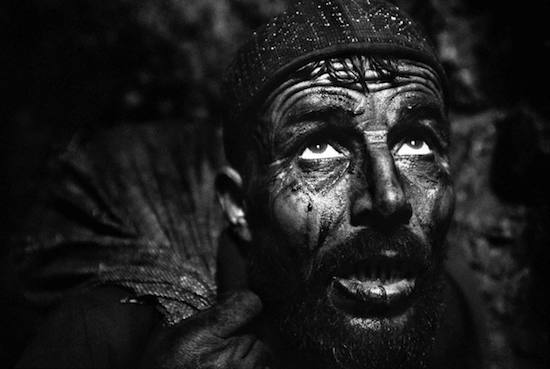
The evening closes on ‘River Anacostia’, a murky dredge through the waters south of Capitol Hill propelled by Johnston’s ominous organ and Parish’s steady beat, as Harvey sings in a high siren’s call: “Walking underwater, flowing with the poisons from the naval yards / Talking to fallen marines, what will become of us?” This question becomes central as images of Washington D.C., then Kosovo and Afghanistan swim up behind them and sync with Harvey’s words as her distorted guitar swells, the unsettling repeated refrain ‘God’s going to trouble the water’ mirrored by images of kids playing in water, then an Osama Bin Laden broadcast on a grainy television set circa 2001, and finally a view through the window of a Kosovo apartment to a room ablaze, resting on the same confrontational photograph that began the evening. With the night having come full circle, only now do Harvey and Murphy come together to join hands and bow out with their associates.
In her collaborations with Murphy, Harvey is not only asking difficult questions, but pushing against the restrictions usually placed on artists to stay within a certain remit or medium. The overall project surrounding The Hollow Of The Hand has fuelled photography, poetry, short-film, music, a public recording installation, and even a feature film by Murphy which will coincide with Harvey’s upcoming album next year. Few other artists today are pushing themselves to such varied undertakings, and even fewer could pull it off with the same sense of unity as PJ Harvey. It does seem she is transitioning to a new phase of her career, one with wider artistic possibilities to explore and which tonight proves she is capable of undertaking. Ultimately, The Hollow Of The Hand is more than a book of words and images, it is a gesture at what is yet to come.
Photographs by Seamus Murphy

